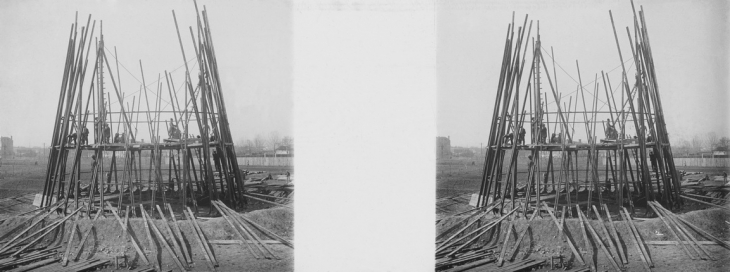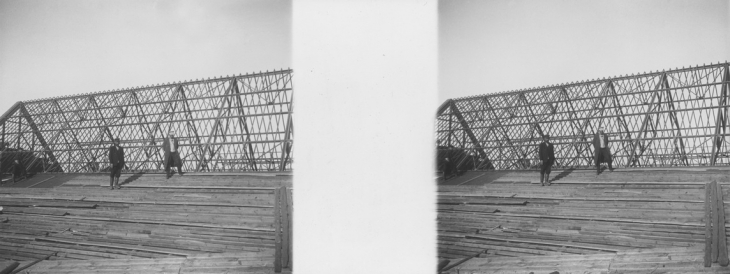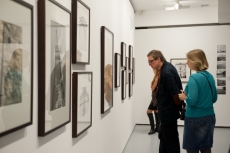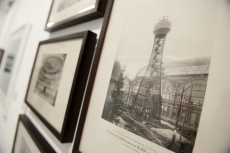The Hyperboloid of Engineer Shukhov












Vladimir Shukhov. Construction of the tower for the Comintern Radio Station in Shabolovka Street in Moscow. The elevation of the 5th section. December, 1921. The Shukhov Tower Foundation, Vladimir Shukhov’s private archive
Vladimir Shukhov. Comintern Radio Station. Shabolovka Street, Moscow. Spring-summer, 1922. The Shukhov Tower Foundation, Vladimir Shukhov’s private archive
Vladimir Shukhov. Construction of water-tower engineered by Vladimir Shukhov. The height of the tower is 25.6 metres. The tank’s capacity is 600,000 litres. Nikolaev, Ukraine. 1905. Stereoscopic photograph. The Shukhov Tower Foundation, Vladimir Shukhov’s private archive
Vladimir Shukhov. Construction of Kievsky (Bryansky) Railway Station in Moscow. Design by Ivan Rerberg, engineering by Vladimir Shukhov. 1916. The Shukhov Tower Foundation, Vladimir Shukhov’s private archive
Vladimir Shukhov. Construction of the Alexander III Museum of Fine Arts (currently the Pushkin State Museum of Fine Arts) with the exhibition halls’ translucent framings, ceilings and flooring engineered by Vladimir Shukhov. 1911. The Shukhov Tower Foundation, Vladimir Shukhov’s private archive
Vladimir Shukhov. Shukhov’s sons Sergei and Fabian learning to ride a bike. Moscow. 1910. Stereoscopic photograph. The Shukhov Tower Foundation, Vladimir Shukhov’s private archive
Vladimir Shukhov. Shukhov’s daughter Vera in the yard of the house on Smolenski Boulevard. 1904. The Shukhov Tower Foundation, Vladimir Shukhov’s private archive
Vladimir Shukhov. Elections to the State Duma. The voting station of the Khamovniki-Prechistenka electoral district, located in the Bakhrushin School House. Bolshaya Tsaritsinskaya (currently Bolshaya Pirogovskaya) Street, 9. Moscow. March 26, 1906. The Shukhov Tower Foundation, Vladimir Shukhov’s private archive
Vladimir Shukhov. Horse-tram on a Moscow boulevard. 1911. The Shukhov Tower Foundation, Vladimir Shukhov’s private archive
Vladimir Shukhov. Flood in Moscow. Bolshaya Ordynka Street. April 12, 1908. The Shukhov Tower Foundation, Vladimir Shukhov’s private archive
Vladimir Shukhov. View of Moscow with Barsanuphius Monastery in the distance. Taken from the Central Telephone Station in Milyutinsky Side-Street. 1908. Stereoscopic photograph . The Shukhov Tower Foundation, Vladimir Shukhov’s private archive
Vladimir Shukhov riding a bike. Moscow, 1880s. The Shukhov Tower Foundation, Vladimir Shukhov’s private archive
Moscow, 11.10.2013—10.11.2013
exhibition is over
Share with friends
For the press
The mechanical engineer, scientist, inventor and honorary member of the USSR Academy of Sciences Vladimir Grigorievich Shukhov (1853-1939) is renowned for outstanding achievements in various areas of science and technology. For over half a century his diverse scientific, technological and engineering work from the late 1870s to the 1930s was hugely influential in the development of mechanics, power engineering, architecture, construction and transport in Russia. This exceptional scientist contributed to the formation and evolution in the 19th-to 20th-century Russia of a number of new fields: the oil industry, boiler making, pump building and the production of reservoirs, river tankers, steam-driven facilities, gas holders, etc.
Vladimir Shukhov made an important contribution to the construction of public and industrial buildings, as well as bridges, bridge cranes, caissons, nautical and airship hangars, hyperboloid towers (pressure and observation towers), electricity transmission line masts, lighthouse beacons, warship masts, defensive port structures and other facilities. Shukhov created the famous hyperboloid structure (patented in 1899), realised in the construction of gigantic supports for power transmission lines across the River Oka, lighthouses and water pressure towers. In 1930 he devised the State All-Union Standard (GOST) and an Atlas of Hyperboloid Systems. Shukhov designed and supervised the building of a multi-tiered gridshell tower for the Comintern Radio Station (height 150 m) in Shabolovka, Moscow, for the all-union radio transmission system (1919-1922). The unique Shukhov Tower is still functioning and serves as the symbol of television and radio transmission across Russia.
The geography of Vladimir Shukhov’s activities is amazing and its scale is truly all-Russian. He undertook the equipment of the economy throughout Russia, from the capital cities to outlying regions, in the Urals, Siberia, the Transcaucasus, Ukraine, Turkmenia, etc.
In all spheres of his work Vladimir Shukhov not only produced his engineering solutions on a scientific basis, but also compared theoretical calculations with experimental data. As a result, he often succeeded in perfecting engineering designs, and the realisation of set technical tasks was carried out according to new, rational methods.
Given the critical necessity for economy in the use of metal in Russia, Vladimir Shukhov strove to build cheaply as well as durably, setting the goal of devising constructions based on a series of fundamental criteria for cost efficiency for the first time in practice.
The scale of Vladimir Shukhov’s engineering activities is amazing. Between 1878 and 1939 some 2,000 km of pipelines for the transportation of oil and oil products, more than 30,000 vertical cylindrical reservoirs of various dimensions for the storage of oil, water, alcohols, etc., about 100 steel gas holders for the storage of large volumes of gas, about 70 river oil tankers (barges), including some with a length of up to 150 m and lifting capacity of up to 12,000 tons, and approximately 10,000 tubular steam boilers were built all over Russia according to his designs. In Moscow alone more than 60 large-scale unique structures and facilities, more than 150 industrial and railway building structures, about 200 steel gridshell hyperboloid water pressure, railway and observation towers, more than 200 roofing structures for public and other buildings were erected from Vladimir Shukhov’s designs and on the basis of his patents in the field of construction units.
A number of public buildings and industrial technological facilities built by Vladimir Shukhov or according to his plans are still standing and functioning efficiently to this day. Striking examples are provided by the celebrated radio tower in Shabolovka and several machine shops at the Vyksunsky Metallurgical Plant that were designed and built by Vladimir Shukhov more than a hundred years ago.
Vladimir Shukhov’s legacy remains alive for as long as it is utilised by new generations. The theoretical and practical development of principles for oil hydraulics and the construction of pipeline systems as defined in the works of Vladimir Shukhov are used to this day in the building of main-line oil pipes. Today the development of modern technologies for petrol production and petroleum cracking facilities have forged way ahead, but they are based on principles first devised by Shukhov.
He was the first in the world to make use of a supporting steel gridshell for the construction of buildings and towers. Contemporaries regarded the technical achievements of Shukhov’s systems as an original innovation, although the architectural possibilities of the new structures were unknown to them. While Russian architecture was forming an aesthetic attitude to the new forms of engineering or refusing to accept them, engineering creativity developed in line with a judicious understanding of the form and consequently of its utilisation. The engineer’s attempt to find the correct juxtaposition of functional requirements, the laws of statics and the construction possibilities of the material is fundamental to the emergence of structures that show supreme harmony and beauty. The main obstacle to including the constructions of Vladimir Shukhov in the trendsetting processes of architecture in the first third of the 20th century was their novelty in terms of volume and space, which contradicted standard stereotypes for the perception of engineering structures by architects.
Vladimir Shukhov introduced the single-sheet hyperbolic paraboloid of revolution to architecture when he created the first ever hyperboloid constructions (1896). The Shukhov hyperboloid towers that have been preserved are stunning not only for the originality of the engineering concept, but also for the grace of their consummate architectural form. Subsequently, the famous high-tech architects Buckminster Fuller and Norman Foster conclusively established gridshell structures in contemporary building practice. Hyperboloid structures are frequently encountered in the work of such celebrated architects as Antoni Gaudi, Le Corbusier and Oscar Niemeyer. In the 21st century Shukhov’s gridshells became the primary means for shaping avant-garde buildings, including skyscrapers (patent nos. 1894, 1895). Today gridshells facilitate the creation of buildings with very complex forms and are therefore used by such world-famous architects as Frank Gehry (USA), Richard Rogers (UK), Paul Andreu (France), Santiago Calatrava (Spain), Renzo Piano (Italy), Nicholas Grimshaw (UK), Zaha Hadid (UK), Massimiliano Fuksas (Italy) and others. The translucent roof of the British Museum’s inner courtyard and the cupola of the 30 St. Mary Axe Tower («the Gherkin») in London, the gridshell covering of the atrium in the DZ Bank building in Berlin, the hyperboloid air traffic control tower at Barcelona Airport, the gridshell of the theatre in Valencia, the gridshell roof of the Maritime Museum in Osaka, the double gridshell of the Beijing Opera Theatre and the hyperboloid gridshell television tower at Guangzhou were all built on the basis of Vladimir Shukhov’s discoveries.
Harmonically combining the talent of a leading scientist with the intuition of a brilliant engineer, Vladimir Shukhov worked in the most diverse areas of science and technology. Everything he created was at the level of discovery and invention; everything was a breakthrough for its time. Many examples of contemporary architecture and construction that are striking for their innovation and scale originate from Shukhov’s discoveries in the late 19th century.



















